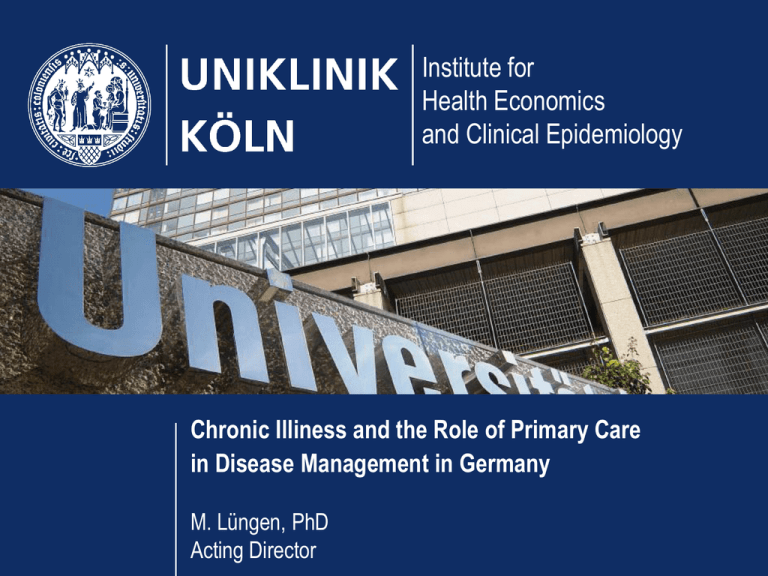Institute for Health Economics and Clinical Epidemiology
advertisement

Institute for Health Economics and Clinical Epidemiology Chronic Illiness and the Role of Primary Care in Disease Management in Germany M. Lüngen, PhD Acting Director Institute for Health Economics and Clinical Epidemiology Institute for Health Economics and Clinical Epidemiology Founded 1996, Institute is part of the University Hospital of Cologne. About 15 scientists (physicians, economists, statisticians). Research: Health policy. Cost-effectiveness analysis, financing. Public health, equity in health care. www.igke.de Luengen@igke.de Seite 2 Characteristics of Primary Care in Germany Physicians in practices 59,000 118,000 Primary care physicians Access without referral. Copayment 10 € per visit Nearly no gate-keeping function No single contracting Fee-for-service scheme Seite 3 Physicians in hospitals Data: Germany, year 2003 Institute for Health Economics and Clinical Epidemiology 59,000 146,000 Specialists (outpatient care) Specialists (inpatient care) Access without referral. Copayment 10 € per visit .......................................... .......................................... No single contracting Fee-for-service scheme Access mostly with referral. Copayment 10 € per day ............................................... ............................................... No single contracting DRG scheme Institute for Health Economics and Clinical Epidemiology Key elements of the German health care system Insured/ Patient Membership Contribution • unrestricted access • no preferred provider • gate-keeping only by 10€ fee per visit in 3 month Nobody really does coordination of care in Germany Provider prescription Pharmacy (Drugs) payment 200 Health Insurance Companies (statutory health insurance only, about 90% of inhabitants) Seite 4 Institute for Health Economics and Clinical Epidemiology Why was Disease Management introduces in Germany? Problems: Risk selection between health plans: healthy and wealthy insured were preferred due to incomplete measurement of income and morbidity. No grouper for morbidity was available for Germany (lack of scientists, research programs, and data). Competition for quality care for chronic ill was set on the political agenda (not competition for good risks and not competition for efficiency alone). Seite 5 Institute for Health Economics and Clinical Epidemiology How was Disease Management introduced in Germany? Primary Care Physicians Includes into DMP Insured Contribution Fee-forService Disease-Management Program Payment For Insured Management Initiates Health Insurance Companies (health plans) Federal Social-Insurance Authority Quality-Certification Seite 6 Pool of all contributions Institute for Health Economics and Clinical Epidemiology Coordination of care in Disease-Management Programs in Germany Patient Shows diabetes inclusion criteria Gets reminder from EMR Seite 7 Primary Care Physicians Includes patient Health Insurance Compani (health plans) No care managers needed Gets reminder from EMR Provides service Gets quality report Pays management fee to physician Gives information to service organisation, EMR Institute for Health Economics and Clinical Epidemiology Integrating Disease-Management Programms into the riskadjustment scheme (Diabetes Type I) before 2002 Expenditure per year € Mean of all insured from 2002 4,500€ 2,000€ marginal expenditure for diabetes I marginal expenditure for diabetes care 1,920€ man, 50 y. healthy man, 50 y. healthy man, 50 y. healthy Redistribution for healthy was reduced. Redistribution for chronically ill was raised. Seite 8 man, 50 y. healthy Mean of chronic ill diabetes Mean of „healthy“ insured Institute for Health Economics and Clinical Epidemiology Four diseases were selected first for re-distribution, certification etc. re-distribution No. of programs No. of patients per patient per year Diabetes mellitus Type II ~ 3,000 2.1 m + 1,232 € (=4,600 €) Breast Cancer ~ 1,500 74 tsd + 3,864 € (=6,700 €) 80 tsd + 315 € (=2,300 €) 722 tsd + 869 € (=4.600 €) Asthma/ COPD Coronary Heart Disease Data: Germany, year 2006 Seite 9 ~ 200 ~ 800 Institute for Health Economics and Clinical Epidemiology How was Disease Management introduced in Germany? Quality assurance Not the health plan, but physicians (both in offices and hospitals) were allowed to include patients into disease management programs. Physicians get an additional fee for managing patient within disease management, but no pay-for-performance. The high redistribution per patient and year made high controls for including patients necessary (gaming). All disease-management programs must be quality-certified by the „Bundesversicherungsamt“ (Federal Social-Insurance Authority). Seite 10 Institute for Health Economics and Clinical Epidemiology Evaluation: Is there Evidence? First full evaluation of 3-year-period will be available in summer 2007. Today: 1-year-results of several health insurance companies. Limited data of baseline (clinical parameter). Some control groups (matching). Patient surveys of subjective health. Seite 11 Institute for Health Economics and Clinical Epidemiology Were Disease-Management Programms effective in Germany? Diabetes Care (BARMER Ersatzkasse) Non-included patients Included patients 64 % negotiated therapy goals with physicians 81 % 50% got yearly training 66 % 64 % got inspection of feet 89 % reported better management 85 % reported better (subjective) health status 15 % Data: Diabetes Disease-Management Program, BARMER Ersatzkasse, 587 answers, 1 year after program started Seite 12 Institute for Health Economics and Clinical Epidemiology Were Disease-Management Programms effective in Germany? AOK (four regions): Smoking Habits Region 2. Halbjahr 2003 11,6 8,5 Hessen 7,2 1. Halbjahr 2004 11,8 9,0 8,5 Mecklenburg-V. 2. Halbjahr 2004 17,7 12,6 12,3 Bremen 9,5 7,0 6,4 Sachsen 0 2 4 6 8 Prozent 10 12 *Data: 4,800 AOK patients, included in DMP in 06-12/2003 Seite 13 14 16 18 20 Institute for Health Economics and Clinical Epidemiology Were Disease-Management Programms effective in Germany? AOK (four regions): HbA1c Clinical Parameter Diabetes Region 7,27 2. Halbjahr 2003 7,09 7,06 Hessen 1. Halbjahr 2004 7,15 7,05 Mecklenburg-V. 2. Halbjahr 2004 6,98 7,13 7,11 Bremen 7,01 6,88 6,73 6,69 Sachsen 6,4 6,5 6,6 6,7 6,8 Prozent 6,9 7 *Data: 4,800 AOK patients, included in DMP in 06-12/2003 Seite 14 7,1 7,2 7,3 7,4 Institute for Health Economics and Clinical Epidemiology Were Disease-Management Programms effective in Germany? AOK (four regions): Diabetes Care Blood Pressure (systolic) Region 151 143 142 Hessen 1. Halbjahr 2004 150 141 141 Mecklenburg-V. 2. Halbjahr 2003 2. Halbjahr 2004 151 144 143 Bremen 148 142 142 Sachsen 134 136 138 140 142 Prozent 144 146 *Data: 4,800 AOK patients, included in DMP in 06-12/2003 Seite 15 148 150 152 Institute for Health Economics and Clinical Epidemiology Were Disease-Management Programms effective in Germany? AOK (six regions): Eye examinations 95 92 78 78 % 67 32% of diabetes patients got regularly eye examination before introducing disease management programs in Germany. ür Br tt. an de nb ur g Br em en en -W Ba d He Me ss en ck len bu rg -V . Rh ein Rh lan ein d lan dPf Ni alz ed er sa ch se n Seite 16 73 32% Region *Data: AOK patients, reports year 2005 84 90 Institute for Health Economics and Clinical Epidemiology Were Disease-Management Programms effective in Germany? Region Nordrhein: Diabetes 66% of all insured with Diabetes were included in DMP. 63% of all primary care physician practices are certified and joined the DMP. Average of 77 diabetes-patients per practice (250.000 patients) Seite 17 Institute for Health Economics and Clinical Epidemiology Were Disease-Management Programms effective in Germany? Region Nordrhein: Diabetes; Blood Pressure Seite 18 Institute for Health Economics and Clinical Epidemiology Diabetes Mellitus II; Expenditures; Inpatient Care; in € per year Non-included Included in DMP Age Seite 19 Institute for Health Economics and Clinical Epidemiology Germany as a solution? Health plans should not be punished for managing bad risks. Extra payment from the pool for Disease-Management Programs are foreseen in Germany even after using morbidity oriented risk adjustment schemes (inpatient diagnosis, Rx etc.). Get physicians as partners, not as subordinates in questions of guidelines, therapies, and design of programs. Quality oriented programs and budget neutrality. Reduce bureaucracy. Documentation is main reason for low adherence among physicians and patients. Seite 20 Institute for Health Economics and Clinical Epidemiology Key messages 1. Germany has a authority-managed money pool to reward evidencebased, certified Disease-Management Programs. 2. Because of the financial incentive for including patients into the programs, primary care physicians are important partners of the health plans. 3. 4. Certified primary care physicians get normal fee plus additional payment for managing the patients. Main organisation workload is done by IT partners. Evaluations today seems to show an increase in quality and decrease in cost. Seite 21 Institute for Health Economics and Clinical Epidemiology Thank you very much for your attention! Any questions to DMP or health care in Germany? Luengen@igke.de Seite 22




